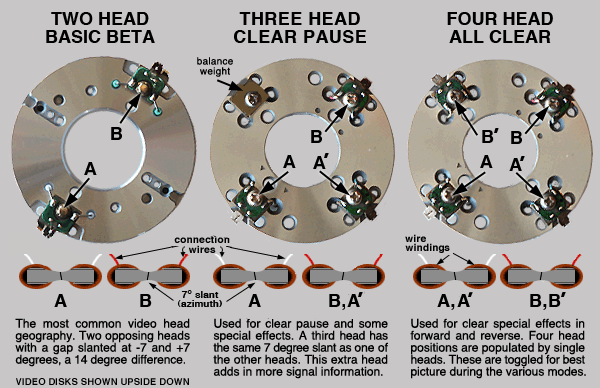|
This recorder uses multiple video heads to accomplish clear pause and special effects. Using more than one head to scan the same and adjacent video tracks helps to create a better picture during special effects. The extra head(s) supplies special circuits in the VCR with duplicate video information. This is then used to fill in areas of the picture that would otherwise be missing and show up as white lines or distorted areas. The three types of head arrangements are shown below. These are used in VCRs made by Sanyo, Toshiba and other non-Sony Betas. The disk on the left is the basic two head 180 degree mounting. The heads are labeled A and B. The two scan the tape twice a second to complete one frame of video. These frames go by so fast that your eye puts them together as a moving image, similar to how movie film works. Two heads are required for creating a continuous stream and work great with regular video playback. But when you pause the tape something interesting happens. The two heads no longer scan the video completely. Because the video was recorded while the tape was moving it is longer that the heads can scan. They now miss parts of the video information. To compensate for this and obtain a better picture in pause a third and sometimes a fourth head is added. These strike the tape in a different location and help fill in the missing signal. The disk in the center of the illustration shows what a three head disk design looks like. The third head, the A' (sometimes called the "trick" head), comes on during pause to help clean up the picture by picking up missing video. The VCR changes how it reads this information and puts it all together electronically to create a better pause picture. Having an extra head also helps during search and step-motion. But to get an almost clear picture in these demanding modes requires a four head arrangement. The disk on the right is the four head disk design. With this one each video track is scanned twice during special effects and the video becomes a lot cleaner. 
|